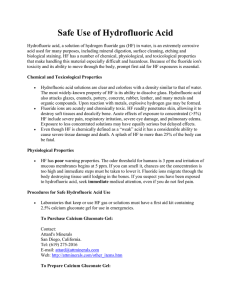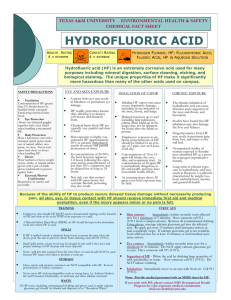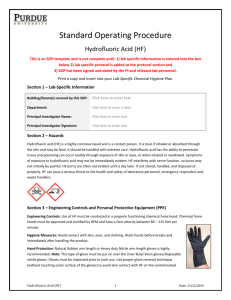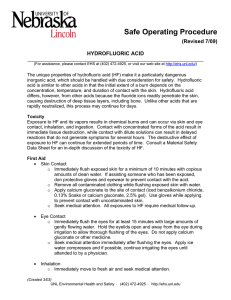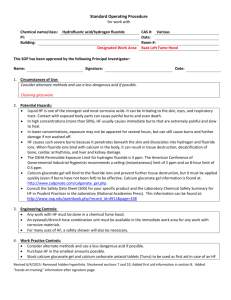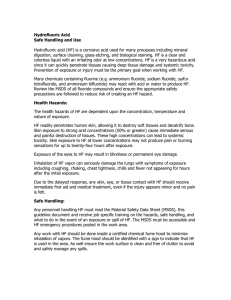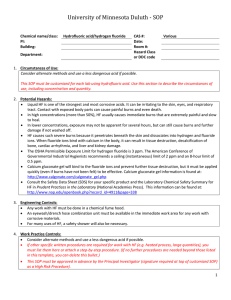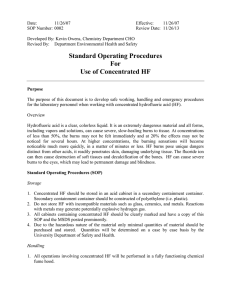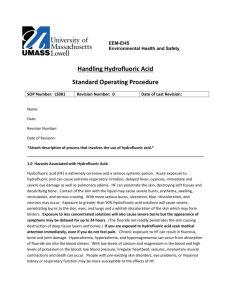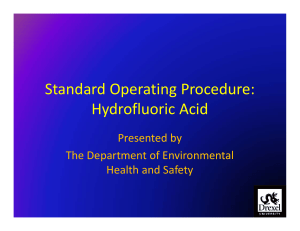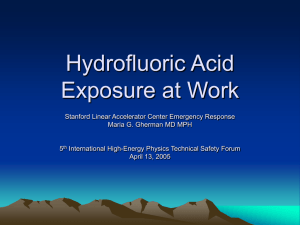Hydroflouric Acid - Environmental Health & Safety
advertisement
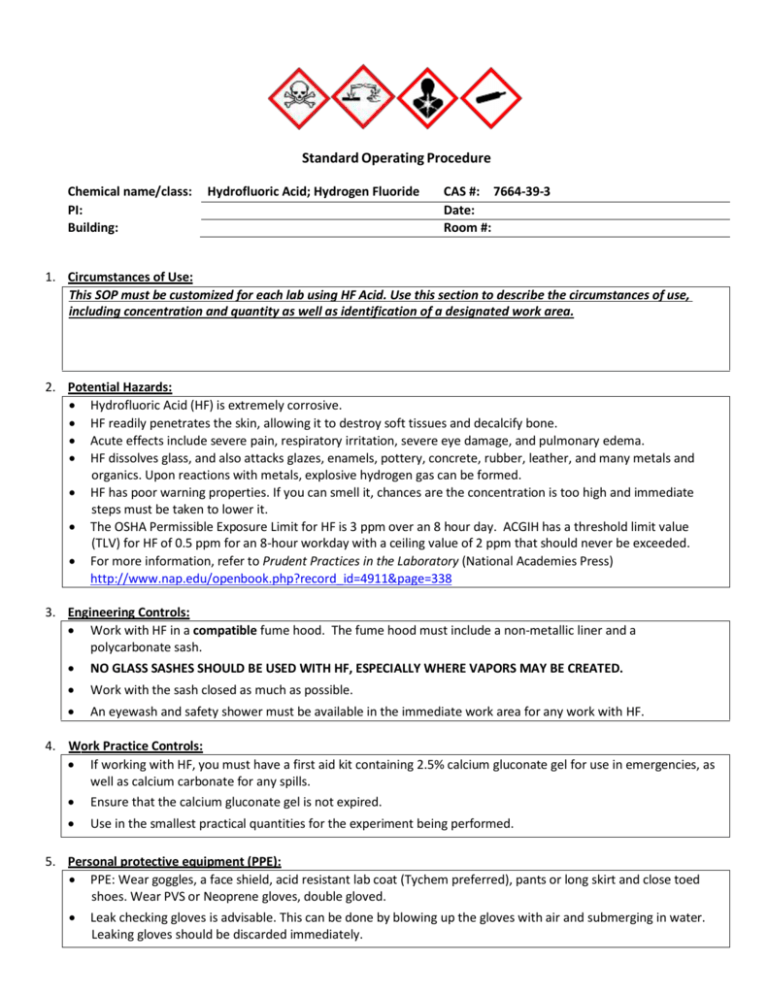
Standard Operating Procedure Chemical name/class: PI: Building: Hydrofluoric Acid; Hydrogen Fluoride CAS #: 7664-39-3 Date: Room #: 1. Circumstances of Use: This SOP must be customized for each lab using HF Acid. Use this section to describe the circumstances of use, including concentration and quantity as well as identification of a designated work area. 2. Potential Hazards: Hydrofluoric Acid (HF) is extremely corrosive. HF readily penetrates the skin, allowing it to destroy soft tissues and decalcify bone. Acute effects include severe pain, respiratory irritation, severe eye damage, and pulmonary edema. HF dissolves glass, and also attacks glazes, enamels, pottery, concrete, rubber, leather, and many metals and organics. Upon reactions with metals, explosive hydrogen gas can be formed. HF has poor warning properties. If you can smell it, chances are the concentration is too high and immediate steps must be taken to lower it. The OSHA Permissible Exposure Limit for HF is 3 ppm over an 8 hour day. ACGIH has a threshold limit value (TLV) for HF of 0.5 ppm for an 8-hour workday with a ceiling value of 2 ppm that should never be exceeded. For more information, refer to Prudent Practices in the Laboratory (National Academies Press) http://www.nap.edu/openbook.php?record_id=4911&page=338 3. Engineering Controls: Work with HF in a compatible fume hood. The fume hood must include a non-metallic liner and a polycarbonate sash. NO GLASS SASHES SHOULD BE USED WITH HF, ESPECIALLY WHERE VAPORS MAY BE CREATED. Work with the sash closed as much as possible. An eyewash and safety shower must be available in the immediate work area for any work with HF. 4. Work Practice Controls: If working with HF, you must have a first aid kit containing 2.5% calcium gluconate gel for use in emergencies, as well as calcium carbonate for any spills. Ensure that the calcium gluconate gel is not expired. Use in the smallest practical quantities for the experiment being performed. 5. Personal protective equipment (PPE): PPE: Wear goggles, a face shield, acid resistant lab coat (Tychem preferred), pants or long skirt and close toed shoes. Wear PVS or Neoprene gloves, double gloved. Leak checking gloves is advisable. This can be done by blowing up the gloves with air and submerging in water. Leaking gloves should be discarded immediately. 6. Transportation and Storage: Group III, Non-oxidizing inorganic acid Do not store in glass or metal. Store HF in Teflon or Polyethylene containers only. Store in secondary containment. Avoid storing on the floor. Transport HF in secondary containment, preferably a polyethylene container. 7. Waste Disposal: Handle and store HF waste following the guidelines above while accumulating wastes and awaiting chemical waste pickup. Chemical waste must be disposed of following UNC Charlotte’s Laboratory Chemical Waste Management practices https://safety.uncc.edu/laboratory-and-research-safety/hazardous-universal-waste. 8. Exposures/Unintended contact: Skin: Immediately remove all contaminated clothing. Move the victim immediately under an emergency shower or other water source and flush the affected area for five minutes with large amounts of water. Immediately washing off the acid is crucial. Immediately apply 2.5% calcium gluconate gel into the burn site. Apply the gel every fifteen minutes afterwards until medical assistance is available. Eye: Immediately flush eyes for fifteen muinutes. Take victim to a physician as soon as possible. Apply ice water compresses if possible. Inhalation: Immediately move the victim to fresh air. Seek immediate medical attention. Ingestion: Dilute acid by drinking copious amounts of milk. Do not induce vomiting. Seek immediate medical attention. Medical attention: In the event of minimal skin contact, contact Brocker Health Center at 7-7400. For all other exposures, immediately call 911. The work-related injury or illness report found at: http://safety.uncc.edu/workers-compensation/workers-compensation-section 9. Spill Procedure: If a small quantity (<100 ml) of dilute HF is spilled, clean it up by applying powdered calcium carbonate or calcium hydroxide, or use a commercial HF spill kit. Contact EH&S to dispose of the material. On the UNC Charlotte campus, “large” spills of HF, or spills of concentrated HF must be referred to the Campus Police by calling 911 from a campus phone or 704-687-2200 from any phone. 10. Training of personnel: All personnel are required to complete the UNC Charlotte EHS Laboratory Environment Training Checklist. This checklist includes an introduction to general chemical safety as well as review of the laboratory specific safety plan. Furthermore, all personnel shall read and fully adhere to this SOP when handling the chemical. “I have read and understand this SOP. I agree to fully adhere to its requirements.” Last First UNC Charlotte ID Signature

